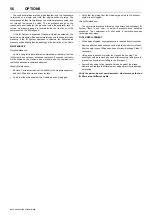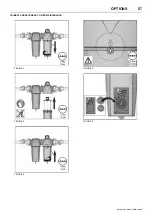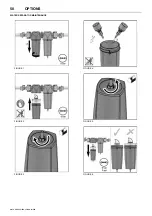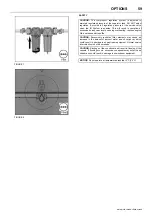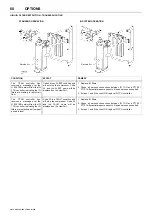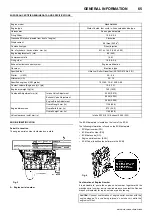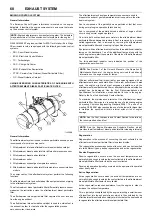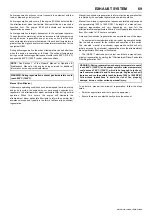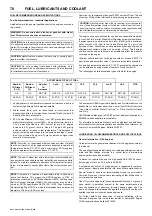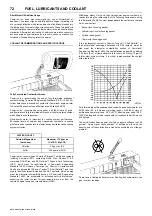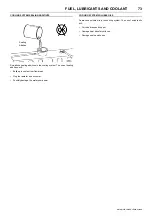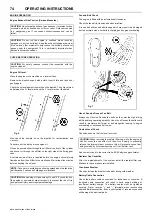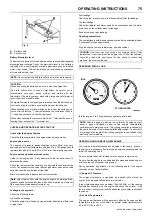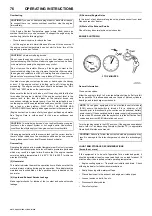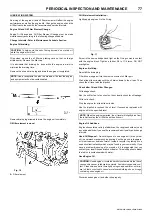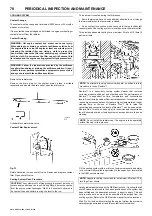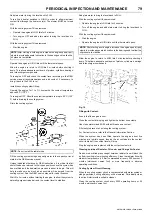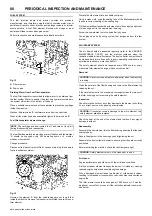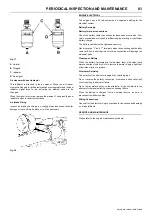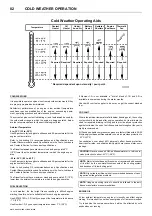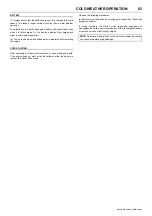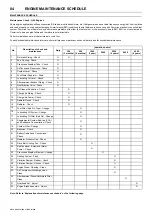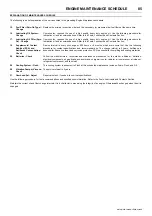
70
FUEL, LUBRICANTS AND COOLANT
9/275, 9/305, 12/250, 17/240, 21/220
FUEL RECOMMENDATIONS AND SPECIFICATIONS
Fuel Recommendations - Industrial Applications
Listed below are the general specifications for the engines covered in
this manual:
Cummins Inc. recommends the use of ASTM number 2D fuel. The use
of number 2D diesel fuel will result in optimum engine performance.
The engine has been optimised for use with an exhaust aftertreatment
to meet the Tier 4 interim/Stage IIIB off-highway emissions regulations.
It
must
operate on ultra-low sulfur diesel (ULSD) with a maximum
sulfur content of 15 ppm in the United States and 10 ppm in the
European Union. Failure to do so can permanently damage engine and
aftertreatment systems within a short period of time. This damage
could cause the engine to become inoperable and affect the warranty
coverage on the engine.
Ultra-low sulfur diesel fuel, for Europe should not exceed 0.0010 (10
ppm) mass percent sulfur content. There is no acceptable substitute.
At operating temperatures below 0°C (32°F), acceptable performance
can be obtained by using blends of number 2D and number 1D.
The following chart lists acceptable types of fuels for this engine.
1. Any adjustment to compensate for reduced performance with a fuel
system using alternate fuel is
not
warrantable.
2. Winter blend fuels, such as those found at commercial fuel
dispensing outlets, are combinations of number 1D and number 2D
diesel fuel, and are acceptable.
3. BTU Content/Degree API Gravity - Low API gravity fuels have a
higher thermal energy content (BTU). As a general rule, there is a
3 to 5 percent decrease in BTU content for every 10 degree
increase in API gravity; there is also a 0.7 degree API gravity
increase with an increase in fuel temperature. This decrease in
energy content equates roughly to the same percentage of power
loss. Use of fuels with higher API gravity will cause higher than
normal fuel consumption.
The equipment OEM is required to display readily visible labels on the
dashboard (or instrument panel) and near all fuel fill inlets that state
"Use Ultra Low-Sulfur Diesel Fuel Only" or "Ultra Low-Sulfur Diesel
Fuel Only"
ULSD/Biodiesel blends up to B20 (20 percent biodiesel) supplied by a
BQ9000 certified supplier are acceptable.
For information on alternative fuels, such as biodiesel, and additional
information for fuel recommendations and specifications, reference the
Fuels for Cummins® Engines, Bulletin 3379001.
LUBRICATING OIL RECOMMENDATIONS AND SPECIFICATIONS
General Information - QSL Engines
Listed below are the general specifications for the engines covered in
this manual:
The use of quality engine lubricating oils, combined with appropriate oil
drain and filter change intervals, is a critical factor in maintaining
engine performance and durability.
Cummins Inc. requires the use of a high-quality SAE 15W-40 heavy-
duty engine oil, such as CJ-4 or Euro ACEA E9.
A sulphated ash limit of 1.0 mass percent is suggested for optimum
piston deposit, diesel particulate filter life, and oil consumption control.
Special "break-in" oils are not recommended for use in new or rebuilt
Cummins® engines. Use the same lubricating oil that will be used in
normal engine operations.
Use of "synthetic engine oils" (those made with API group 3 or group 4
base stocks) is permitted, subject to the same performance and
viscosity limitations of petroleum (mineral) based engine oils. The
same oil change intervals
must
be applied to synthetic oils that are
applied to petroleum (mineral) based engine oils.
For further details and discussion of engine lubricating oils for
Cummins® engines, refer to the latest revision of Cummins® Engine
Oil Recommendations, Bulletin 3810340.
WARNING: Do not mix petrol, alcohol, or gasohol with diesel
fuel. This mixture can cause an explosion.
CAUTION: Due to the precise tolerances of diesel injection systems,
it is extremely important that the fuel be kept clean and free of dirt or
water. Dirt or water in the system can cause severe damage to both
the fuel pump and the fuel injectors.
CAUTION: Lighter fuels can reduce fuel economy or possibly dam-
age fuel system components.
CAUTION: Do not use diesel fuel blended with lubricating oil in
engines equipped with an aftertreatment system. Service intervals
for aftertreatment systems will be reduced.
CAUTION: Ultra-low sulfur diesel fuel is required for correct opera-
tion of the aftertreatment system. If ultra-low sulfur diesel fuel is not
used, the engine could possibly not meet emission regulations and
the aftertreatment system could possibly be damaged.
ACCEPTABLE TYPES OF FUEL
Number
1D Diesel
(1) (2)
Number
2D Diesel
(2)
Number
1K
Kerosene
Jet-A
Jet-A1
JP-5
JP-8
Jet-B
JP-4
CITE
OK
OK
NOT OK
NOT OK
NOT OK
NOT OK
NOT OK
NOT OK
NOT OK
NOT OK
48-34(3)
40-24(3)
50-35(3)
51-37(3)
51-37(3)
48-36(3)
51-37(3)
57-45(3)
57-45(3)
57-45(3)
NOTE:
Cummins Inc. recommends that the cetane number of diesel
fuel be a minimum of 45 for engines that are expected to operate at
temperatures below 0°C (32°F) and a minimum of 42 for engines
that are operated at temperatures above 0°C (32°F).
NOTE:
The use of diesel fuel with a lower than recommended cet-
ane number can cause hard starting, instability, and excessive white
smoke. To maintain satisfactory operation at low ambient tempera-
tures, it is important to specify diesel fuel of the correct cetane num-
ber.
NOTE:
Cummins Inc. requires all permissible fuels to have ade-
quate fuel lubricity. This means the BOCLE number is 3100 or
greater as measured by ASTM specification D6078, Scuffing Load
Ball On Cylinder Evaluator (SLBOCLE). Lubricity can also be mea-
sured by ASTM, specification D6079, ISO 12156, High Frequency
Reciprocating Rig (HFRR), in which the fuel
must
have a wear scar
diameter of 0.45 mm (0.02 in) or less.

